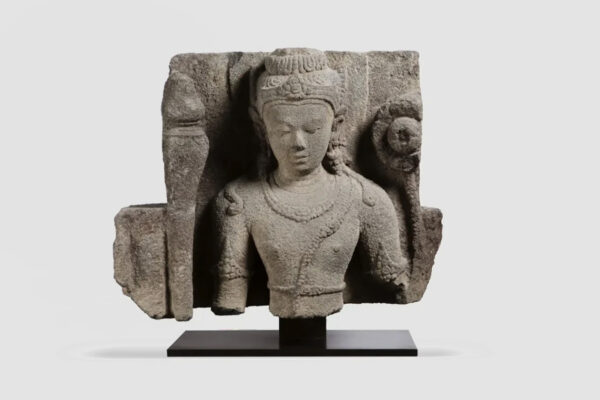Wood estimate
Do you own an Asian wooden object and want to know its value? Whether you’re a passionate collector or have inherited a family heirloom, having your wooden piece appraised is a crucial step in understanding its potential. Our experts in Asian wooden objects offer you a free, confidential estimate within 48 hours.
The use of wood in Asian art is rooted in a long tradition of craftsmanship. This material, appreciated for its malleability, durability and ability to take on refined forms, is used for a wide variety of objects. From furniture to religious sculptures and everyday objects, wood – often from rare species such as huanghuali, zitan or hongmu– is sculpted, lacquered, inlaid with mother-of-pearl or decorated with precious metals to create exceptionally rich works of art.
Estimates and prices of Asian wooden objects on the market :
Prices for Asian wooden objects at auction can vary considerably depending on several factors: the type of object, the rarity of the wood used, the period of production and the artistic quality. Here is an overview of the price ranges observed at auction:
| Typology | Price range (€) | Record price (€) |
| Furniture in precious woods | 1 500 – 65 000 € | 65,000 € (carved hongmu table, 19th century) |
| Religious sculptures | 1 500 – 62 000 € | 62,000 € (large carved wooden head, 19th century) |
| Decorative objects (screens, panels, etc.) | 1 000 – 102 000 € | 102,000 € (wood and duanstone screen, 18th century) |
| Items for everyday use | 300 – 22 000 € | 22,000 € (huanghuali folding armchair, 20th century) |
Why should I have my Asian wooden object appraised?
There are several advantages to obtaining an accurate estimate for your wooden object:
- For an auction: If you’re planning to sell your item, knowing its current value helps you set a fair and attractive price.
- For insurance: In the event of a claim or damage, an estimate enables you to insure your room properly.
- As part of an inheritance: If you have inherited a wooden object, an appraisal may be necessary for inheritance tax purposes or to divide the inheritance fairly.
- Curiosity: You simply want to know the value of your object, especially if it’s an heirloom or family memento.
How can you have your wooden object appraised with Asium?
Nothing could be simpler! You can request an estimate directly online via our form. Simply upload photos of your wooden object and add a description. Our experts will get back to you within 48 hours with a confidential estimate.
For larger collections or high-value objects, we also offer in-home appraisal services or the possibility of participating in our appraisal days, where you can bring your object for an in-person appraisal.
A recent example of estimation:
Recently, a carved teakwood statue was appraised at 4,500 euros, testifying to the growing interest in exceptional pieces of wood on today’s market.
Typologies and Specificities of Asian Woodwork
1. Precious Wood Furniture
Asian wooden furniture, particularly from China and Vietnam, is of great importance in the history of decorative art. Precious woods such as huanghuali (黃花梨), hongmu or zitan are often used for high-quality furniture pieces.
- Huanghuali console (20th century): Estimated at €3,000 to €4,000, it sold for €22,000.
- Carved hongmu wood table (19th century): One of the most remarkable pieces, estimated between €40,000 and €60,000, sold for €65,000.
Prices for Asian furniture range from €1,500 to €65,000, with record-breaking pieces fetching very high prices for rare species or period creations.
2. Religious sculptures
Religious woodcarvings occupy an important place in Asian art, especially in China and Nepal. They often depict Buddhist deities such as Guanyin or Buddha, carved in precious or polychrome wood.
- A large carved wooden head (19th century) sold for €62,000, well above its initial estimate of €1,000 to €1,500.
- A wooden Guanyin figure from the Ming dynasty (1368-1644), estimated at between €8,000 and €12,000, sold for €8,000.
These sculptures generally sell for between €1,500 and €62,000, depending on quality, period and rarity.
3. Decorative objects
Wooden decorative objects include screens, carved panels, or mother-of-pearl inlaid elements. They are often used as ornamental elements or furniture, particularly in China and Japan.
- A wood and duanstone screen (China, 18th century), an extremely rare piece, achieved a record price of €102,000, against an estimate of €30,000 to €50,000.
- A pair of carved wood panels (India, 19th century) sold for €2,500, well above the initial estimate of €400-600.
Decorative wooden objects can sell for between €1,000 and €102,000, depending on their rarity and period of production.
4. Objects of Everyday Use
Everyday objects made of wood include armchairs, tables or objects such as brush holders or bamboo boxes. These pieces, often carefully crafted and adorned with carved or inlaid details, are prized for their functional and aesthetic appeal.
- A huanghuali folding armchair (China, 20th century), estimated at €6,000-8,000, sold for €22,000.
- A bamboo box (China, 18th-19th century) sold for €1,600.
Prices for everyday objects range from €300 to €22,000, with high prices for precious woods.
Regional Specificities in the Use of Wood in Asian Art
1. China: The Sophistication of Precious Woods
In China, the use of wood in art and crafts is particularly refined, with a predilection for certain rare and precious wood species:
- Huanghuali (黃花梨): This tropical rosewood, native to the island of Hainan, is one of China’s most prized woods. Primarily used to make furniture during the Ming (1368-1644) and Qing (1644-1912) dynasties, it is prized for its warm color, fine texture and durability. Pieces such as consoles, armchairs and tables can fetch very high prices, as illustrated by huanghuali folding armchairs sold for €22,000.
- Zitan (紫檀): Extremely rare and dense, zitan wood is often used for imperial furniture and decorative objects. It is dark, almost purple in color, and prized for its strength and resistance to insects. A small cabinet in zitan wood from the 19th century sold for €8,000.
- Hongmu: This reddish wood is more affordable than huanghuali and zitan, but still highly sought-after. It is used in the manufacture of imposing, carved furniture. A remarkable example is a carved hongmu table sold for €65,000.
China is also known for its religious wood carvings, representing Buddhist deities such as Guanyin or Buddha, with particular attention paid to carved detail and polychromy.
2. Japan: the elegant simplicity of lacquered wood
In Japan, woodworking has a spiritual dimension, in harmony with nature. Wood is often used for lacquering, an ancient technique involving the application of several coats of lacquer to achieve a smooth, glossy finish.
- Lacquered and gilded wood: Japan is famous for its lacquered wood furniture and objects, often adorned with gilding and mother-of-pearl inlays. The Meiji period (1868-1912) saw a large-scale production of these objects, with cupboards, cabinets and decorative screens designed for the nobility. A lacquered and gilded wooden cabinet from the Meiji period sold for €1,700.
- Wood Sculptures: Religious statues in gilded lacquered wood, representing Buddhas or Bodhisattvas, are masterpieces of Japanese heritage. A Buddha sculpture in gilded lacquered wood sold for €2,150, reflecting the importance of this style in Japanese religious art.
3. Vietnam: The Art of Mother-of-Pearl-Inlaid Wood
Vietnam has a long tradition of woodworking, particularly for furniture and decorative objects. One of Vietnam’s specialities is the inlaying of mother-of-pearl into wood to create complex, elegant patterns.
- Mother-of-Pearl-Inlaid Wood: 19th-century Vietnamese furniture is often made of hardwood, inlaid with mother-of-pearl for floral motifs or scenes of daily life. A 19th-century buffet in mother-of-pearl-inlaid wood sold for €8,400, while a cabinet in exotic inlaid wood sold for €6,700.
4. Nepal and India: Religious and Decorative Sculptures
In Nepal and India, wood is mainly used for religious and decorative sculptures. These regions, influenced by Buddhism and Hinduism, produce wooden statues depicting deities and spiritual motifs.
- Nepalese sculptures: Nepal is renowned for its wood-carved heads and statues of Buddhist and Hindu divinities. An 18th-century female head sold for €1,800 at auction.
- Indian carved wood: In India, wood is also used for decorative panels and carved bas-reliefs. Nineteenth-century carved wood panels sold for €2,500, well above their estimate.
5. Burma: Gilded Buddhist sculptures
In Burma (Myanmar), wood is commonly used for religious sculptures, notably Buddha statues often covered in gilding.
- Gilded Buddha: One of the specialities of Burma is the application of a thin layer of gold leaf to wooden statues to give them a sacred dimension. A large 20th-century Buddha in gilded wood sold for €2,100, illustrating the value of these objects in today’s auctions.
Factors Influencing the Value of Asian Woodwork
1. The rarity of wood
Certain woods, such as huanghuali or zitan, are extremely rare and valued for their durability and aesthetic appeal. Objects made from these species often fetch very high prices, as demonstrated by folding armchairs and consoles selling for tens of thousands of euros.
2. The Production Period
Period objects, especially those from the Ming or Qing dynasties in China, are particularly sought-after. The older the object and the better its condition, the higher its value at auction.
3. State of preservation
The state of preservation is essential in the appraisal of a wooden object. Overly visible restorations or major alterations can reduce its value, while a piece in excellent condition or with a beautiful original patina will be much more prized.
4. Manufacturing Technique
The techniques of carving, lacquering, mother-of-pearl inlaying and polychromy play an important role in the value of a wooden object. Elaborate pieces with meticulous details and complex finishes attract collectors and can drive up prices at auction.
Conclusion
Works in Asian wood, whether religious, decorative or utilitarian, form a category of their own in art and antiques. Recent auctions show a wide range of prices, reflecting the diversity of the objects and the growing demand for these exquisite pieces. If you own a piece of Asian woodwork, or wish to acquire one, it is crucial to consult an expert for an accurate estimate based on the wood species, the period of production, and the overall condition of the object.
Our experts in wood
-

TaHsi CHANG
Specialist in the arts of VIETNAM and CHINA
-

Anna KERVIEL
JAPAN Expert
-

Eunbi HA
-

Jean GAUCHET
ASIA Expert
Our areas of expertise
What factors influence the resale price of an Asian wooden object?
Customers may want to know which elements, such as rarity, provenance, or the general condition of the object, impact its value on the resale market.
How can I check the provenance of my Asian wooden object?
They might wonder how to prove the origin of their piece. Practical advice on searching for documents, sales history, or identifying craftsmen can be very useful.
How can you tell the difference between an authentic Asian wooden object and a modern reproduction?
Customers may wonder what specific visual or tactile characteristics to look for to avoid buying reproductions or imitations. Practical advice on how to identify signs of authenticity would be invaluable.
Previously appraised by Asium
The Asium estimation service is...

Simple
and free
A few photos of your work, a few words of description and you're all set !

Fast
but not too fast
Our experts are serious, they take the time to research and get back to you within a week.

Reliable
and confidential
Our auctioneers are the Sherlock Holmes of the art market.































